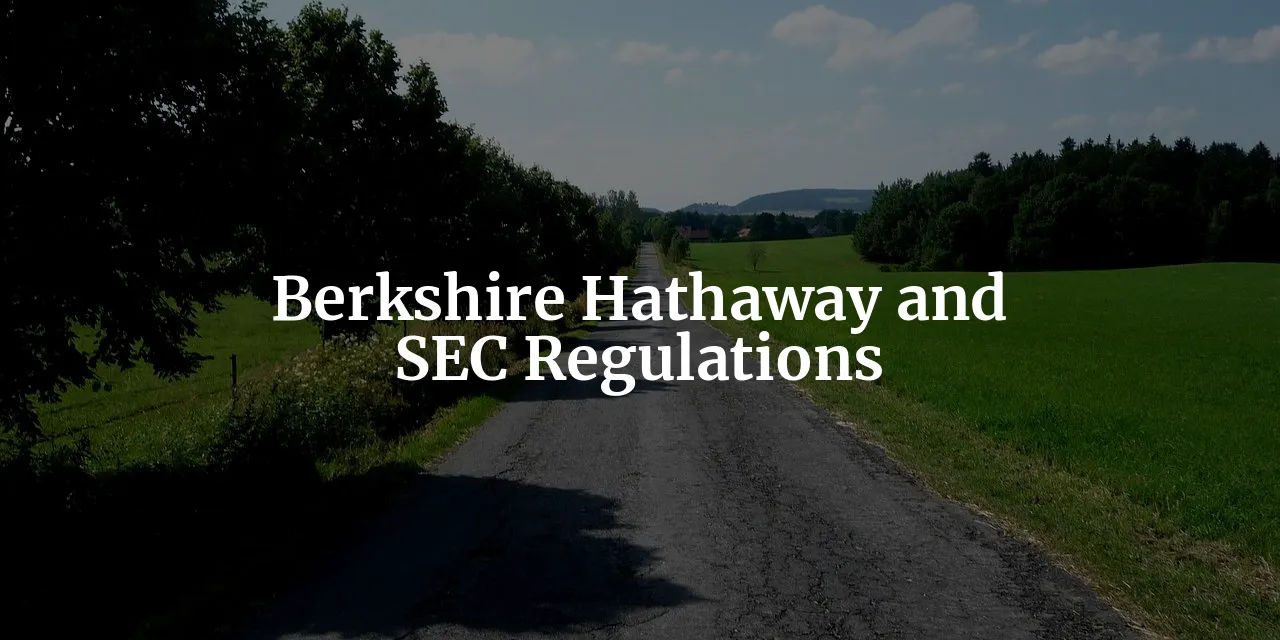Tags: History
This fanpage is not officially affiliated with Berkshire Hathaway: Disclaimer
The recent revelation of Berkshire's stake in Chubb ↗ got us thinking: What are Berkshire's ownership reporting obligations and why are they in place? Explore the impact of federal securities laws and SEC regulations.

Introduction
Let us go way back about four hundred years, when "security regulation" probably wasn't even part of the dictionary: The Tulip Mania, which occurred in the Dutch Republic during the years 1636-37, is often cited as one of the first recorded speculative bubbles. Several conditions and factors contributed to this phenomenon. We might oversimply it to excessive human greed without (regulatory) boundaries. At the bubble's height, the prices of tulip bulbs reached extraordinary levels, with some rare bulbs selling for more than the cost of a house. Ordinary people, including tradesmen and farmers, began participating in the market, often leveraging their assets to invest in tulips. And losing everything.
From today's perspective it might seems cumbersome how the Tulip Mania played out. Common sense should have prevented it, surely three centuries would have been enough time to impose some useful rules on the stock market, right? Well...
The Stock Market Crash of 1929 and the subsequent Great Depression were seismic events that reshaped the financial landscape of the United States. On Black Monday, October 28, 1929, the Dow Jones Industrial Average plummeted nearly 13%, followed by another devastating drop of almost 12% on Black Tuesday. By mid-November, the Dow had lost nearly half its value, and it wouldn't return to its pre-crash heights until November 1954 6. These cataclysmic events exposed the vulnerabilities of a market driven by speculation and devoid of robust regulatory oversight.
The purpose of this article is to explore why Berkshire Hathaway needs to report 5% ownerships, delving into historical, political, and economic insights that have shaped these requirements. Understanding these reporting obligations is crucial for Berkshire Hathaway shareholders, as it underscores the importance of transparency and disclosure in maintaining investor confidence and market integrity. Transparency and disclosure are vital in this context, as they ensure that investors have access to balanced, non-fraudulent information, which is essential for making informed decisions ↗.
In this article, we will journey through the historical development of federal securities laws, the creation of the Securities and Exchange Commission (SEC), and the modern regulatory environment that necessitates Berkshire Hathaway's reporting obligations. We will also examine the role of transparency and disclosure in maintaining market integrity and the broader economic and political insights that underpin these regulations.
The underline the importance of the topic, let's recall a famous quote by Warren Buffett: "It takes 20 years to build a reputation and five minutes to ruin it. If you think about that, you'll do things differently." This sentiment encapsulates the essence of why transparency and disclosure are paramount, not just for regulatory compliance but for maintaining the trust and confidence of investors.
The Birth of Federal Securities Laws
The speculative frenzy and lack of disclosure that characterized the stock market in the 1920s set the stage for the catastrophic events of 1929. Brokers sold stock to investors based on promises of large profits, often with little to no disclosure of relevant information 4. This environment of unchecked speculation and greed culminated in the Stock Market Crash of 1929, an event that had devastating consequences around the world and would forever alter the financial regulatory landscape.
On Black Monday and Black Tuesday, the stock market experienced unprecedented declines, leading to widespread economic fallout. Share prices plummeted, and the ensuing panic caused funds to flow into commercial banks in New York City, straining the financial system 6. The Federal Reserve attempted to curb speculation by raising the discount lending rate, but this move had unintended consequences on the international economy. Despite efforts by banks to restore confidence, the crash's impact was profound, leading to job losses, reduced consumer spending, and a severe curtailment of economic activity 6.
In response to these events, the Securities Exchange Act of 1934 3, signed into law by President Franklin D. Roosevelt on June 6, 1934, established the Securities and Exchange Commission (SEC) to restore public confidence in the markets 10. The SEC was created to regulate the securities industry, demanding more disclosure and setting strict reporting schedules for companies offering securities to the public. This marked a significant shift from the state-level Blue Sky Laws, which were weak in terms and enforcement, allowing for manipulation 10.
The Blue Sky Laws, enacted already in 1911, required companies to disclose information to potential investors but were limited in their effectiveness. The federal securities laws aimed to address these gaps by providing a more robust framework for investor protection 10. The core theme of these laws is disclosure, ensuring that investors have access to balanced, non-fraudulent information, which is crucial for maintaining market integrity 4. Over the years, the SEC has been empowered through various acts, including the Securities Act of 1933, and more recently, the Sarbanes-Oxley Act of 2002 and the Dodd-Frank Wall Street Reform and Consumer Protection Act 10.
The Federal Reserve's actions during the crash, including purchasing government securities and lowering the discount rate, helped contain the crisis in the short run 6. However, the lessons learned from this period emphasized the need for a more structured regulatory environment to prevent such speculative frenzies and ensure financial stability.
These historical developments have had a lasting impact on the modern regulatory environment that Berkshire Hathaway operates within. The requirement for Berkshire Hathaway to report 5% ownerships is rooted in these foundational principles of transparency and disclosure, which are essential for maintaining investor confidence and ensuring the integrity of the financial markets.
Reporting Requirements Under the Exchange Act
The Securities Exchange Act of 1934 3 established a comprehensive framework for regulating securities transactions on the secondary market. Among its many provisions, the Act introduced stringent reporting requirements to ensure transparency and protect investors. For shareholders of Berkshire Hathaway, understanding these requirements is crucial as they directly impact the company's reporting obligations and to some extent also its investment strategies. Let us have a look at the main aspects:
a) Section 13(d) and Schedule 13D
Under Section 13(d) of the 1934 Act, any beneficial owner acquiring more than 5% of a class of equity securities in a publicly traded company must file a Schedule 13D with the Securities and Exchange Commission (SEC) 13. This report must be filed within 10 days of crossing the 5% ownership threshold and includes detailed information about the acquisition, including the purpose of the transaction and future plans regarding the issuer. For a company like Berkshire Hathaway, which frequently acquires significant stakes in other companies, compliance with Section 13(d) is a routine yet critical aspect of its operations 2.
As you can see, 5% do matter!
b) Schedule 13G
Qualified Institutional Investors and Passive Investors can opt to file a short-form Schedule 13G instead of the more detailed Schedule 13D. Qualified Institutional Investors, such as mutual funds and pension funds, must file Schedule 13G within 45 days after crossing the 5% threshold. If their ownership exceeds 10%, or if there is a 5% increase or decrease in their holdings, an amendment must be filed within 10 days. Passive Investors, who acquire shares without intending to influence control, must file their initial Schedule 13G within 10 days of crossing the 5% threshold and amend it within 45 days after the end of the year if there are material changes 2.
Both Schedule 13D and 13G filings must be amended promptly to reflect any material changes in ownership. For Schedule 13D, this includes any significant changes in the purpose of the acquisition or plans regarding the issuer. For Schedule 13G, amendments are required within 10 days of exceeding the 10% ownership threshold or a 5% change in holdings 2.
c) Form 13F
Form 13F is another critical filing for institutional investment managers with over $100 million in qualifying assets under management. These managers must file Form 13F quarterly, disclosing their long positions in publicly traded securities, including U.S. exchange-traded stocks, ETFs, options, warrants, and some convertible debt securities 7. The filing includes a cover sheet, a statement of disclosed positions, and an information table detailing the positions. The deadlines for Form 13F filings are 45 days after the end of each quarter, typically on February 14th, May 15th, August 14th, and November 14th 7.
As an institutional investment manager with substantial holdings, Berkshire's portfolio is meticulously reported to the SEC. These filings reveal Berkshire's long positions, providing a snapshot of its investment strategy at the end of each quarter. For shareholders, these disclosures are invaluable, offering a detailed look at the company's investment decisions and portfolio composition.
For the outlined filings, the following thresholds and deadlines exist:
| Form | Threshold | Initial Filing Deadline | Amendment Requirements |
|---|---|---|---|
| Schedule 13D | >5% ownership | 10 days | Promptly for material changes |
| Schedule 13G | >5% ownership (Qualified Institutional Investors) | 45 days | 10 days for >10% ownership or 5% change |
| Schedule 13G | >5% ownership (Passive Investors) | 10 days | 45 days after year-end for material changes, promptly for >10% |
| Form 13F | >$100 million in assets | 45 days after quarter-end | Quarterly filings |
The reporting requirements under the Exchange Act have evolved significantly since the 1930s. Initially, the focus was on preventing market manipulation and ensuring transparency. Over the decades, the SEC has refined these requirements, introducing new forms and amending existing ones to adapt to the changing landscape of the financial markets. The introduction of Form 13F in the 1970s marked a significant step towards greater transparency in institutional investment activities 7.
Berkshire Hathaway has consistently complied with these reporting requirements, providing timely and detailed disclosures about its significant investments. For shareholders, these filings offer valuable insights into the company's investment strategy and portfolio composition. By adhering to these regulations, Berkshire not only meets its legal obligations but also reinforces its commitment to transparency and accountability.
In the case of the recent revelation of Berkshire's position in Chubb Berkshire Hathaway received approval from the SEC to delay the disclosure of its Chubb stake. The SEC has a provision called "confidential treatment" under Regulation 13D that allows for a temporary delay in public disclosure in certain situations. Here's how it might have worked:
- Request for Confidentiality: Berkshire Hathaway could have submitted a written request to the SEC seeking confidential treatment for their Chubb stake.
- Justification: The request would need to explain why public disclosure would be harmful to Berkshire Hathaway and outline the specific details they want to keep confidential.
- SEC Review and Decision: The SEC would then review the request and decide whether to grant confidential treatment. This decision would depend on the merits of Berkshire's justification and whether it aligns with the SEC's objectives.

The Role of the SEC in Shaping Berkshire Hathaway
The Securities and Exchange Commission (SEC) has played a pivotal role in shaping the structure and strategy of Berkshire Hathaway. The SEC's actions in the mid-1970s, particularly its investigation into Blue Chip Stamps, had a profound impact on Warren Buffett and his approach to managing Berkshire Hathaway.
In 1974, the SEC questioned Blue Chip Stamps, a company controlled by Buffett, for allegedly manipulating the share price of Wesco Financial. Although Buffett was fined $115,000, no fault was found against him. This incident, however, underscored the importance of adhering to SEC regulations and maintaining transparency in all transactions. The experience influenced Buffett's decision to merge Diversified Retailing and Blue Chip Stamps into Berkshire Hathaway, streamlining operations and ensuring greater regulatory compliance 9 ↗.
The SEC has the authority to bring civil charges against companies and individuals found guilty of fraud and securities violations. Historical examples, such as the enforcement actions against Enron and WorldCom, illustrate the SEC's role in maintaining market integrity. For Berkshire Hathaway, compliance with SEC regulations is not just a legal requirement but a cornerstone of its reputation and trustworthiness 10.
SEC regulations might have significantly influenced Berkshire Hathaway's investment strategy effectively acting as boundary conditions limiting Berkshire's possibilities, for example in secret acquisitions ↗. The stringent disclosure requirements ensure that Berkshire provides detailed information about its investments, fostering transparency but often with a direct impact on securities prices through the "Buffett effect".
The Blue Chip Stamps ↗ case is a prominent example of the SEC's impact on Berkshire Hathaway. The SEC's investigation raised questions about Berkshire Hathaway's ownership structure, specifically regarding potential conflicts of interest. While the exact motivations behind the merger remain unknown, Warren Buffett restructured his operations in 1970 by merging Blue Chip Stamps and Diversified Retailing into Berkshire Hathaway. This simplification of the corporate structure potentially addressed some of the transparency concerns raised during the investigation and ensured better compliance with SEC regulations 9.
The SEC's dual mission of protecting investors and ensuring market efficiency aligns closely with Berkshire Hathaway's reporting obligations. By enforcing strict disclosure requirements and maintaining a robust regulatory framework, the SEC helps create a level playing field for all market participants. For Berkshire Hathaway, this means adhering to high standards of transparency and accountability, ultimately benefiting its shareholders and the broader investment community.
The Importance of Transparency and Disclosure
Investor Confidence: Transparency and disclosure are the bedrock of investor confidence. In the annals of investing history, episodes of deceit, folly, and irrational exuberance have repeatedly eroded trust in the markets. The implementation of federal securities laws, particularly following the stock market crash of 1929, was a direct response to these malpractices. By mandating full and fair disclosure, the Securities Act of 1933 and the Securities Exchange Act of 1934 aimed to provide investors with balanced, non-fraudulent information, thus preventing speculative frenzies and market manipulation 4.
Disclosure Requirements: Under the Exchange Act, companies are required to file several key reports to ensure transparency. These include annual reports (Form 10-K), quarterly reports (Form 10-Q), and event-driven reports (Form 8-K) 5. These reports are designed to keep investors informed about the company’s financial health, operational performance, and any significant changes or events that could impact its stock value.
Regulation FD: Regulation FD (Fair Disclosure) plays a crucial role in ensuring that all investors have equal access to material information. This regulation prohibits companies from selectively disclosing information to certain investors, thereby promoting a level playing field 5. By ensuring that all investors receive the same information simultaneously, Regulation FD helps maintain market integrity and investor trust.
Impact on Market Behavior: The stringent disclosure requirements under the Exchange Act have a profound impact on market behavior and investor decision-making. When companies are transparent about their operations and financial status, it reduces the risk of misinformation and speculation. Investors can make informed decisions based on accurate and timely data, which in turn promotes market stability and efficiency.
Berkshire's Disclosure Practices: Berkshire Hathaway exemplifies adherence to these disclosure practices. The company’s annual reports are renowned for their comprehensive and candid insights, often penned by Warren Buffett himself. These reports not only comply with regulatory requirements but also provide shareholders with a deeper understanding of the company’s philosophy, strategy, and performance. This level of transparency has been instrumental in building and maintaining shareholder trust.
Below is an overview of the SEC disclosure forms:
| Form | Description | Filing Deadline |
|---|---|---|
| 10-K | Annual report providing a comprehensive overview of the company’s business and financial condition | Within 60 days of fiscal year-end |
| 10-Q | Quarterly report providing unaudited financial statements and information on the company’s operations | Within 40 days of quarter-end |
| 8-K | Current report to announce major events that shareholders should know about | Within 4 business days of the event |
For Berkshire Hathaway shareholders, these disclosure practices offer numerous benefits. They ensure increased transparency, enabling shareholders to make informed decisions based on a clear understanding of the company’s performance and prospects. In the case of Berkshire Hathaway the task is not easy, though, as the company not only exhibits a famous investment portfolio, but also many independently run subsidiaries 8 ↗. Berkshire's comprehensive SEC filings, in turn, foster a sense of security and trust, which is crucial for a long-term investment.
As discussed, the Great Depression, triggered by the stock market crash in October 1929, had profound and long-lasting effects on the global economy. The Dow Jones Industrial Average, which had soared to unprecedented heights, plummeted dramatically, losing nearly 89% of its value by the summer of 1932 6. This economic catastrophe exposed the vulnerabilities in the financial system and underscored the need for robust financial regulation.
In response to the economic turmoil, the U.S. government enacted a series of political reforms in the 1930s. The Glass-Steagall Act and the creation of the SEC were pivotal in reshaping the financial industry 10. These reforms aimed to restore public confidence, regulate the stock market, and prevent the recurrence of such economic disasters. The lessons learned from the Great Depression remain relevant today. The 2008 financial crisis serves as a stark reminder of the importance of robust financial regulation. Just as in the 1930s, the crisis of 2008 led to significant regulatory reforms, including the Dodd-Frank Wall Street Reform and Consumer Protection Act. These measures were designed to address the systemic risks and prevent the kind of speculative excesses that had precipitated the crisis. Stricter disclosure requirements, enhanced corporate governance standards, and increased oversight of financial institutions were introduced.
The political debates surrounding financial regulation are ongoing. While some argue for stricter regulations to protect investors and prevent financial crises, others caution against over-regulation, which they believe could stifle innovation and economic growth. These debates are crucial as they shape the regulatory landscape and influence the operating environment for companies like Berkshire Hathaway.
Looking ahead, the future of financial regulation is likely to be shaped by emerging trends and challenges. Issues such as cybersecurity, cryptocurrencies, and environmental, social, and governance (ESG) criteria are expected to gain prominence.
Transparency in financial markets is not just a regulatory requirement; it is a cornerstone of market stability. The disclosure of institutional holdings through Form 13F filings helps prevent systemic risks by ensuring that market participants are well-informed. This transparency fosters trust and confidence among investors, contributing to a more stable and resilient financial system. By making their positions public, institutional investors like Berkshire Hathaway help maintain the integrity of the markets.
Retail investors stand to gain significantly from tracking the holdings of successful institutional investors. These 13F filings provide a unique opportunity to identify potential investments, diversify portfolios, and spot emerging investment themes or trends. By analyzing the disclosed positions of renowned investors, retail investors can enhance their research and due diligence, making more informed investment decisions. However, it is crucial to remember that Form 13F filings should be just one piece of the puzzle, and investors must conduct their own thorough analysis before making any investment moves.
Over the years, Berkshire's filings have revealed significant stakes in companies like Apple, Bank of America, and Coca-Cola. By examining these filings, investors can discern patterns in Berkshire's investment strategy, such as its preference for companies with strong brand recognition, robust financials, and long-term growth potential.

Conclusion
The historical discourse surrounding Berkshire Hathaway's 5% ownership reporting obligations sheds light on the importance of transparency, disclosure, and regulatory compliance in the financial markets. The Stock Market Crash of 1929 and the subsequent Great Depression serve as stark reminders of the consequences of unchecked speculation and lack of disclosure. Through the establishment of federal securities laws and the creation of the Securities and Exchange Commission (SEC), the regulatory framework was set to restore investor confidence and ensure market integrity.
Berkshire Hathaway's adherence to reporting requirements under the Exchange Act, including Section 13(d) and Schedule 13D, reflects its commitment to transparency and accountability. The role of the SEC in shaping Berkshire Hathaway, through enforcement actions and regulatory oversight, has influenced the company's corporate governance practices and investment strategies. By complying with SEC regulations, Berkshire Hathaway upholds its reputation and trustworthiness among shareholders and the broader investment community.
The importance of transparency and disclosure cannot be overstated, as they are essential for maintaining investor confidence and market stability. The economic and political insights gained from historical events like the Great Depression and the 2008 financial crisis underscore the need for robust financial regulation. Institutional investors, like Berkshire Hathaway, play a crucial role in providing transparency through Form 13F filings, offering valuable insights for retail investors and contributing to market integrity.
Berkshire Hathaway shareholders can benefit from understanding the complexities of financial regulation, the role of institutional investors, and the significance of transparency in the markets. By staying informed, conducting due diligence, and leveraging the insights gained from regulatory filings, investors can make informed decisions that align with their long-term investment goals.
References
-
Officers, Directors and 10% Shareholders - www.sec.gov ↩
-
Acquiring more than 5% of a publicly traded company - www.investmentfundlawblog.com ↩↩↩
-
Securities Exchange Act of 1934 - www.nyse.com ↩↩↩
-
securities law history - www.law.cornell.edu ↩↩↩
-
Securities Exchange Act of 1934 - www.law.cornell.edu ↩↩
-
Stock Market Crash of 1929 - www.federalreservehistory.org ↩↩↩↩↩
-
Form 13F: What It Is, Filing Requirements, and How Investors Can Use It - www.investing.com ↩↩↩
-
The Management of Berkshire Hathaway - www.gsb.stanford.edu ↩
-
The SEC created Berkshire Hathaway??? - www.lunarmobiscuit.com ↩↩
-
The SEC: A Brief History of Regulation - www.investopedia.com ↩↩↩↩↩↩












